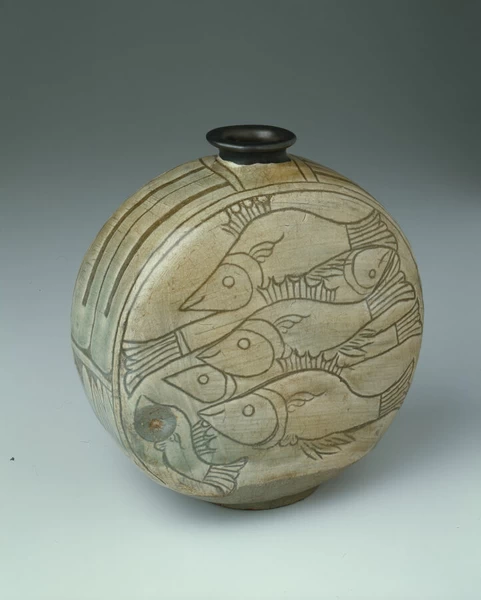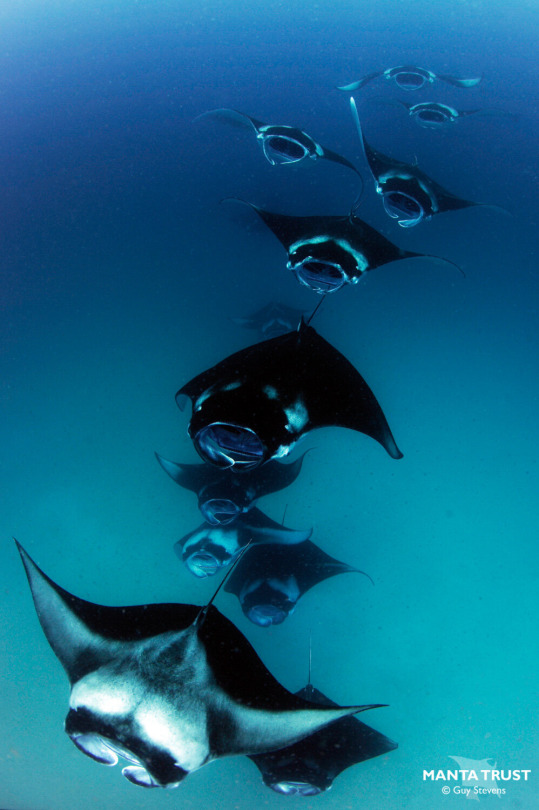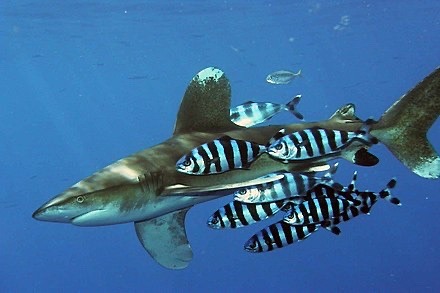Posts on Fridays. May include marine mammals and reptiles. Ripoff of that TikTok fotw account. Counterpart of thefuckingfrogs. Don’t ask me for money or talk in my blog about NSFW.
Last active 2 hours ago
Don't wanna be here? Send us removal request.
Text
fish.




fishy pieces of Korean Buncheong Ceramics from Leeum, Samsung Museum of Art
everyone love and appreciate the beautiful color of the clay/white slip used on these lovely works !!
154 notes
·
View notes
Text
Fish of the Week #3: The Reef Manta Ray

The reef manta ray (Mobula alfredi) is a member of the Mobulidae family, also known as Mobulid Rays.
It is the second-largest species of ray, behind only its counterpart, the giant oceanic manta ray. They tend to be 10-11.5 feet (3-3.5 meters), but can grow up to 16 feet (5 meters).
It can be found widely in the tropical and subtropical Indo-Pacific, in the waters around southeastern Asia and Australia.
It is listed as vulnerable on the IUCN. While there are few natural predators of the manta ray, overfishing has put their numbers in a steady decline over the last several years. The demand has increased because of a pseudo-medicinal attribute assigned to their gill rakers (without any significant evidence).
Fun facts:
The reef manta ray was only confirmed as a separate species from the giant oceanic manta ray (Mobula birostris) in 2009.
Manta rays have been one of the only non-human species to pass the mirror test, considered a prerequisite for sapient status in animals and something that even dogs have failed.
The protrusions on the sides of the manta ray’s face are called cephalic lobes or horns.
———
Here are some ways you can distinguish between the oceanic and reef manta ray!
1. Size.
- Where reef mantas tend to be 10-11.5 feet, oceanic mantas are usually 13-16 feet (4-5 m). This will only work for mature rays, however.
2. Colors and patterns.
- The reef manta ray will have two lighter colored markings on the sides of its head, fading as the color goes down its back, with the darker color above and around it forming nearly a Y shape. In contrast, the oceanic manta’s colors will not fade slowly and the darker color around it will form more of a T shape.
- While the oceanic manta will have dark markings on the inner sides of their cephalic lobes, the reef manta will not. In addition, the reef manta will have spots more spread out on its underside, but the oceanic manta will only have them on its lower abdomen and the spots will be closer together.
———
I love manta rays.
#fishblr#fish#fotw#fish of the week#fotw 3#fish of the week three#manta ray#manta ray fish#reef manta ray#reef manta ray fish#fishy friday
6 notes
·
View notes
Text

Thank you for telling me that. :) I just thought the image looked cool, honestly, but I appreciate the correction.
Fish of the Week #2: The Pilot Fish

The pilot fish (Naucrates ductar) is a member of the trevally, or jackfish, family. It is a widely distributed fish, found in warm/tropical open seas.
It is known to follow ships, and many ancient people believed that it would navigate a ship towards its desired course.
Many are often found near sharks, rays, or sea turtles, eating ectoparasites (parasites that latch onto the skin of a host) and their larger companion’s leftovers.
Despite being seen with many other marine creatures, pilot fish appear to have a more mutualistic relationship with the white-tip reef shark in particular. It benefits them both because the fish is protected and the shark is free from parasites.

Younger or smaller pilot fish in particular are known to swim into sharks’ mouths to clean their teeth.
Fun facts:
It can temporarily change color when excited, with its black bands turning into a lighter blue or silvery shade.
The pilot fish’s name may have come from one of three things. They swam near ships when they were near ports and were believed to guide or “pilot” the captain towards them. They were also believed to lead sharks to their food and ships, whales, or swimmers to safety.
In Greek myth, a sailor named Pompilus helped a nymph Ocyrhoe flee from Apollo. He moved her to Samos and Apollo punished him by turning him into a fish.
Pancrates of Arcadia, a Greek poet, stated that it was a sacred fish to Poseidon and that a fisherman (called Epopeus) ate one and paid for it with his life.
———
This was a far more interesting one than the hickory shad. I especially liked the myths I read about it.
7 notes
·
View notes
Text
Fish of the Week #2: The Pilot Fish

The pilot fish (Naucrates ductar) is a member of the trevally, or jackfish, family. It is a widely distributed fish, found in warm/tropical open seas.
It is known to follow ships, and many ancient people believed that it would navigate a ship towards its desired course.
Many are often found near sharks, rays, or sea turtles, eating ectoparasites (parasites that latch onto the skin of a host) and their larger companion’s leftovers.
Despite being seen with many other marine creatures, pilot fish appear to have a more mutualistic relationship with the white-tip reef shark in particular. It benefits them both because the fish is protected and the shark is free from parasites.

Younger or smaller pilot fish in particular are known to swim into sharks’ mouths to clean their teeth.
Fun facts:
It can temporarily change color when excited, with its black bands turning into a lighter blue or silvery shade.
The pilot fish’s name may have come from one of three things. They swam near ships when they were near ports and were believed to guide or “pilot” the captain towards them. They were also believed to lead sharks to their food and ships, whales, or swimmers to safety.
In Greek myth, a sailor named Pompilus helped a nymph Ocyrhoe flee from Apollo. He moved her to Samos and Apollo punished him by turning him into a fish.
Pancrates of Arcadia, a Greek poet, stated that it was a sacred fish to Poseidon and that a fisherman (called Epopeus) ate one and paid for it with his life.
———
This was a far more interesting one than the hickory shad. I especially liked the myths I read about it.
7 notes
·
View notes
Text
Midterms are happening this week. I’ll post fotw 2 next Friday.
1 note
·
View note
Text
Shad thanks you. He is happy.
Shad despairs, for none have appreciated his existence.
3 notes
·
View notes
Text
When they find my body, indeed.
If I get one more notification on this damn blog before @3nthyu5 gets a like on their first fish of the week post…
WHEN THEY FIND MY BODY.
3 notes
·
View notes
Text
Shad despairs, for none have appreciated his existence.
3 notes
·
View notes
Text
Fish of the Week #1: The Hickory Shad

The hickory shad (Alosa mediocris) is a fish, indeed. It is also known as a silver shad, fall herring, mattowacca, freshwater taylor or bonejack. It is part of the saltwater herring family and feeds on squid, small fish, fish eggs, and small crustaceans.
It can be found off of the east coast of the U.S., from Florida to Maine, and their largest populations are found in the Chesapeake Bay and the coast of North Carolina.
It can be distinguished from the American shad, which it is often confused or grouped with in fishing statistics, by its protruding lower jaw.
Fun Facts:
The hickory shad has something called a humeral spot, which is that dark patch right behind the fish’s gill. A lot of fish have this.
It is an anadromous fish, meaning that it lives most of its life in the oceans and goes into freshwater parts of rivers to spawn.
The largest one ever caught was 2lb 10oz (~1.2 kg).
———
This is… not a very fun fish to start out with. The wheel must be obeyed, however, and who am I to deny it? Hopefully the next one will be better.
Bonus:

Art I made of this fish. No color, because I didn’t have any pencils or markers with me at the time.
#fish of the week#fish#fishblr#fotw#hickory shad#hickory shad fish#fotw 1#fish of the week one#a fish indeed#fishy art#queue fotw#fishy friday
8 notes
·
View notes
Text

I believe he is inquiring as to why you have no bitches.
4 notes
·
View notes
Text

The shape of a fish's caudal tail can tell you a lot about how fast the fish moves! A rounded tail is the slowest and a lunate tail is the fastest! The lunate tail has the most optimal ratio of high thrust and low draw, making it the fastest.
Ichthyology Notes 2/?
41K notes
·
View notes
Text
Hi, I’m Rei or Enthyus.
This is a blog about fish, because my friend is really into fish and I want to learn more about them. Because I have poor foresight, however, I have chosen to do this by making a wheel of every fish species ever and spinning it to see what I get for the Fish of the Week. I might take requests for fish/marine animals people want to hear about as well if this blog gets popular enough.
I’ll use any pronouns, I don’t really care what you call me. I am not comfortable with NSFW blogs or people looking for money contacting me about NSFW or money, and those who do will have their asks/replies deleted and their accounts blocked.
My profile picture is of a ribbon eel. He is my son and his name is Jeremy. Everyone say hi to Jeremy.
Welcome to FotW. Glad to have you.
Tags:
fotw / fish of the week : fish of the week. If you want to look for a specific number, it’s a space and then the number for the abbreviation, or the word version of the number for the non-abbreviated version. If you want a specific fish, search that instead.
something fishy : non-fotw posts.
fry asks : response to an ask.
fishy art : art I made. I sign it with a little image of Jeremy.
fishy friday : posts made on Fridays.
Posted Fishes
1: Hickory Shad
2:
3:
#fish#fishblr#fotw#fish of the week#something fishy#I’ve decided to call my followers ‘fry’.#apparently.#fry asks#fishy art#fishy friday
6 notes
·
View notes
